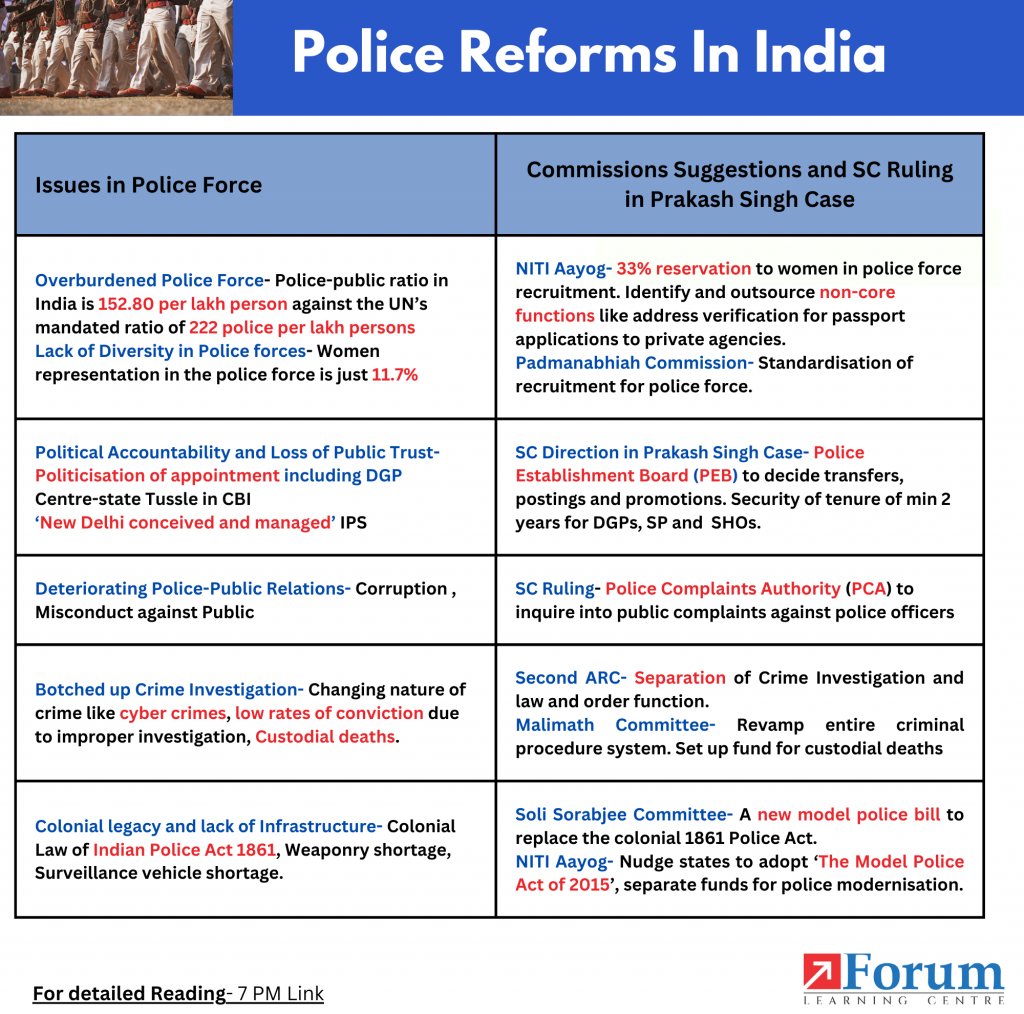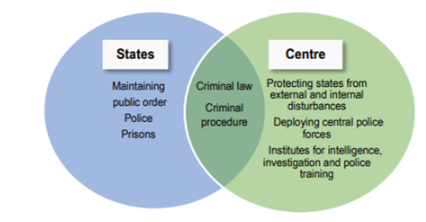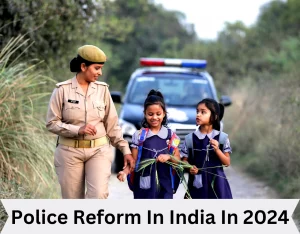ForumIAS announcing GS Foundation Program for UPSC CSE 2025-26 from 19 April. Click Here for more information.
PM Narendra Modi emphasised on the need of Police Reform at the recent DGP, IGP meet. PM emphasised on the need of modernisation of the police forces and exhorted them to ‘work with data instead of danda’. With the changing nature of crime like threats of cyber crime, we need to act urgently on reforming the old and outdated policing system in India.

What is Police Reform? What is The Constitutional and Legal Basis of Police System in India?
Police reforms aim to transform the values, culture, policies and practices of police organizations. It envisages police to perform their duties with respect for democratic values, human rights and the rule of law.
Constitutional and Legal Basis of Police System in India
| Police is an exclusive subject under the State List (List II, Schedule 7 of the Constitution). However, the centre is also allowed to maintain its own police forces to assist the states with ensuring law and order. For ex- CRPF, CISF. |
| The present Indian police system is largely based on the Police act of 1861. State legislation on policing is based on this Act. For Ex- Bombay Police Act, 1951, Kerala police act 1960, Delhi police act 1978. |

What is The Need For Police Reform in India?
1. Overburdened Police Force- Police-public ratio in India stands at 152.80 per lakh person, against the sanctioned public-police ratio of 196.23 per lakh person (as on 1st January 2022). This is way too low when compared with the UN’s recommended standard of 222 police per lakh persons. This has led to a state of an overburdened police force and a huge backlog of cases.
2. Constabulary Issues- The constabulary constitutes ~86% of the state police forces. However, the constabulary suffers from issues such as limited promotion opportunities (only once in his lifetime) and harsh working conditions (Lack of housing facilities). This has weakened their incentive to perform well.
3. Issues with IPS System- The ‘New Delhi conceived and managed’ IPS has emerged as ‘a permanent irritant’ between the centre and states. States look upon the IPS as unreliable intruders and prefer to have their own recruits. For ex- Tussle over the promotions of Police officers at important positions.
4. Centre-state Tussle- Even though police is a state subject, public prefers CBI investigations over state police interventions as they lack faith in their own police forces, leading to centre-state tussle. For ex- Tussle between WB Police and CBI, Withdrawal of general consent to CBI by WB, TN.
5. Lack of Diversity in Police forces- As per Status of Policing in India Report, 2022, Indian police lacks diversity on the basis of caste, class, religion and gender. Representation of women in the police force is just 11.7% (Jan 2022).
6. Accountability to the Political Executives vs Operational Freedom- The Second ARC (2007) has noted that political interference has interfered with professional decision-making by the police and resulted in a biased performance of duties. For Ex- Politicisation of DGP appointment.
7. Police Infrastructure Issues- The Police suffers from issues like
a. Weaponry shortage (Rajasthan-75% shortage and West Bengal- 71% shortage, according to CAG audit report 2015-16)
b. Surveillance vehicle shortage (30.5% deficiency according to BPRD)
c. Underutilisation of Funds for modernisation of state police forces (Just 6 % of the Rs 620 cr fund for modernisation of state police forces was used in FY23)
d. Non-functioning of POLNET (Police Communication Network)- a satellite-based network to facilitate faster communication between police and paramilitary forces (CAG report highlights the failure of states like Gujarat, Uttar Pradesh in setting up POLNET).
8. Colonial Legacy- The Indian Police is still governed by the Police Act of 1861, which is a colonial law aimed at creating a ‘suppressor police force’ rather than an ‘enabler police force’.
9. Police misconduct and Corruption- In 2016, the vigilance department had conducted 55% more inquiries against its own men. India lacks institutional mechanism to complain against the erring police officials.
10. Deteriorating Police-Public Relations- The Second ARC (2007) has noted that police-public relations is rapidly deteriorating as people view the police as corrupt, inefficient, politically partisan and unresponsive. According to a 2018 survey by CSDS, less than 25% of Indians expressed trust in the police.
11. Changing nature of Crimes- The nature of crimes is becoming more complex like the emergence of various kinds of organized crimes, economic fraud, deepfakes. Police lack modern technological capabilities necessary to perform quality investigations.
12. Botched up Crime Investigation- The 22nd Law Commission has pointed out that conviction rate for crimes recorded under the Indian Penal Code, 1860 is less than 50%. It has pointed out that the police lack training in essential skills like forensic laws, cybercrimes and legal knowledge of admissibility of evidence.
13. Custodial Deaths- As per Asian Centre for Human Rights (ACHR) report, 144 custodial deaths took place from 2017 to 2018. The large number of custodial deaths point towards wide use of torture in police investigations.
What Will Be The Benefits Of Police Reforms in India?
1. Shedding the colonial Legacy- The reform of Indian Police Act will help in shedding the colonial legacy like it was done in the case of IPC, CrPC and Evidence Act being replaced by Bhartiya Nyaya, Surkasha and sakshya Samhitas.
2. Help in tackling Modern day crimes- The reform will help in tackling the modern day crimes like cyberespionage, deepfakes and online financial frauds.
3. Increase in social sensitivity- Diversified workforce like greater representation of women in police force will increase gender sensitivity towards women in the society. For ex- Help in decreasing cases of crimes against women.
4. Reduction in custodial Deaths and Violence- It will help in reducing inhumane tortures in police custody especially of the downtrodden and the disadvantaged. For ex- Reduction in cases like Thoothukudi district custodial death.
5. Bolster Internal security- Modernised Police force will help in bolstering national security and containing crimes like naxalism and separatism.
| Read More- Police Reform- UPSC |
What are The Recommendations of Various Committees Regarding Police Reforms in India?

Various Committee recommendations
| Gore committee 1971-1973 | Enlarge the content of police training from law and order and crime prevention to a greater sensitivity and understanding of human behaviour |
| National Police Commission 1977 | Insulate the police from illegitimate political and bureaucratic interference. |
| Padmanabhaiah Committee 2000 | Standardisation of recruitment procedures for the police force & training. Bring changes in police officers’ behaviour, police investigations and prosecution. Change the criterion for constabulary recruitment and improve pay & perk. |
| Soli Sorabjee Committee 2005 | A new model police bill to replace the colonial 1861 Police Act. |
| Second ARC 2007 | Separation of crime investigation from other police functions like maintenance of law and order. Establishment of State police boards for welfare and grievances redressal mechanisms for police personnel. |
| Malimath Committee 2003 | A complete revamp of the entire criminal procedure system. Creation of fund to compensate victims turning hostile under pressure of culprits. Separate national level authority to deal with crimes threatening the country’s security. |
Seven Directives of The Supreme Court in Prakash Singh vs Union of India
In the Landmark Prakash Singh vs Union of India, for police reforms in India, SC has given the following observations-
a. State Security Commission (SSC)– Constitute a State Security Commission (SSC) so that the state government does not exercise unwarranted influence or pressure on the police.
b. Merit based appointment of DGP– Ensure that the DGP is appointed through the merit-based transparent process and secure a minimum tenure of two years of service.
c. Security of tenure- Police officers on operational duties (including SP and SHO) are also provided a minimum tenure of two year.
d. Criminal Investigation and law and order separation– Separate the investigation and law and order functions of the police.
e. Police Establishment Board (PEB)– Set up a Police Establishment Board (PEB) to decide transfers, postings, promotions and other service related matters of police.
f) Police Complaints Authority (PCA)– Set up a Police Complaints Authority (PCA) at state level to inquire into public complaints against police officers of above the rank of Deputy Superintendent of Police.
g) National Security Commission (NSC)- Set up a National Security Commission (NSC) at the union level to prepare a panel for selection and placement of Chiefs of the Central Police Organizations (CPO) with a minimum tenure of two years.
NITI Aayog Suggestions on Police Modernisation
a. State level legislative reforms- States should be encouraged, with fiscal incentives, to introduce ‘ The Model Police Act of 2015’ as it modernises the mandate of the police.
b. Task force under MHA- To identify non-core functions that can be outsourced to save on manpower and help in reducing the workload of the police. For Ex- Address verification for passport applications can be outsourced to private agents or government departments.
c. Greater representation of women- The states should be encouraged to ensure that the representation of women in the police force is increased. For ex- Bihar’s 33% women in police force rule.
d. Place police and public order in concurrent List- Police as well as public order must be moved to the Concurrent List to tackle increasing inter-state crime and terrorism under a unified framework.
What Should Be the Way Forward?
1. Reform the ‘Thana’- The thana system is the most basic unit of police functioning.Through the thana, the police remains in contact with the common man. Thus, improving the working conditions of thana-level constables should be a priority.
2. Enhance Police Budget and upgrade Police Infrastructure- More than 90% of the police budget in the states are used for salary and establishment costs. Allocation for training, procurement and technology deployment should increase. States must fully use the funds for police modernisation.
3. Reform the criminal justice system- Focus must be on the effective implementation of the Malimath Committee recommendations to reform the criminal justice system.
5. Training and Capacity Building of policemen- Training the police forces should be a continuous process along with the evolving nature of the crime space. For ex- The cyber cell of the Delhi Police to deal with cyber criminals.
6. Upgrade technology and research in policing- Reform the Bureau of Police Research and Development (BPRD) by making it a more inclusive institution. For ex- Expertise of social science experts for better research on criminology, NCRB’s Automated Facial Recognition System(AFRS) to identify criminals.
7. Improving public perception through community policing– Community policing initiatives like ‘Janamaithri Suraksha Project-Kerala’, ‘Meira Paibi-Assam‘ must be undertaken to improve ground level policing.
8. Learning from international best practices- Japan’s separate police commission for recruitment, New York Polices specialisation of police model, must be used to reform our police and make it a global Police.
9. Increase women representation- 33% women reservation in police should be implemented in all the states. States like Bihar have taken a step in this direction.
All reforms must be enunciated in the direction of development of SMART Police– Sensitive, Mobile, Alert, Reliable and Techno-savvy.
| Read More- The Hindu UPSC Syllabus- GS II- Role of Civil Services in a Democracy |





